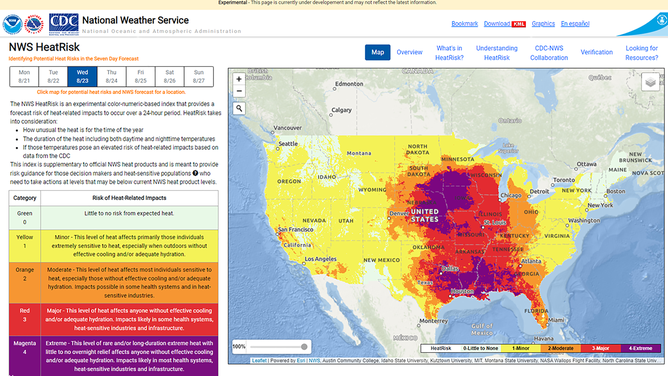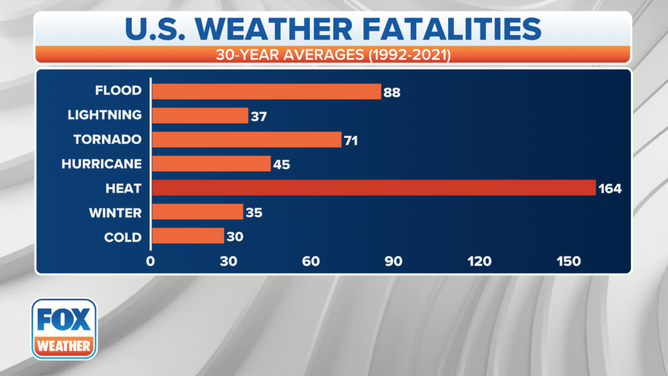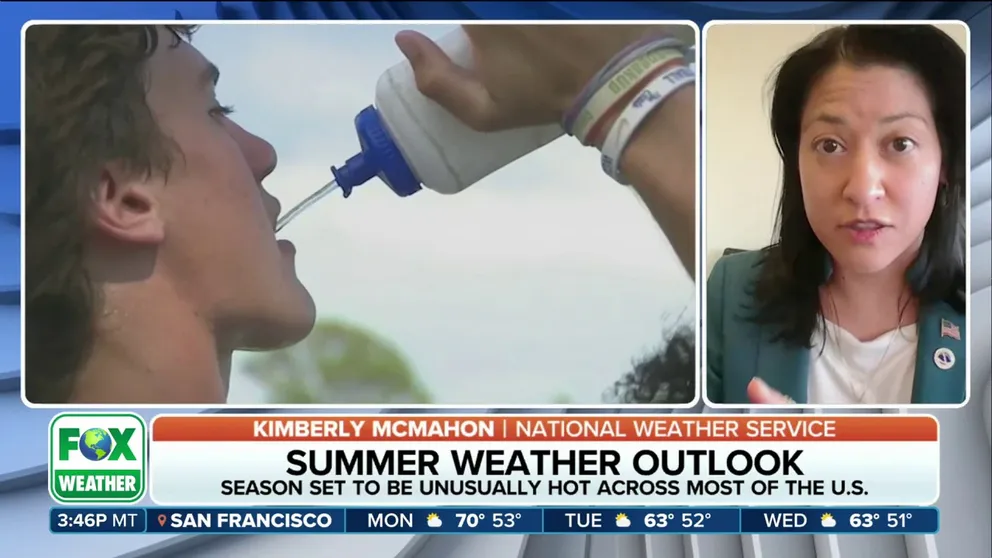HeatRisk: New tool aims to halt climbing number of heat-related deaths in US
HeatRisk is a collaboration between NOAA and the CDC that shows the risk of heat-related illnesses that are 100% preventable across the country.
HeatRisk: Tool for every American to protect us from heat, the nation's top extreme weather killer
Kimberly McMahon from the NWS joined FOX Weather to describe a partnership between NOAA and the CDC which developed HeatRisk. The risk ranking goes beyond just the heat index but looks at the amount of time in a heat wave, as heat illnesses are cumulative.
After the planet's warmest year on record and a record number of heat-related deaths in 2023 for some cities across the nation, U.S. agencies developed a tool to combat heat exposure that anyone with a computer or smartphone can access.
NOAA and the Centers for Disease Control and Prevention partnered to address the skyrocketing number of heat-related deaths each year. The result is called HeatRisk.
PHOENIX'S RECORD SUMMER HEAT KILLED OVER 600 PEOPLE, NEW REPORT SAYS

This is NOAA’s NWS experimental HeatRisk tool website for the contiguous U.S., where NWS forecasts are combined with CDC heath-heat data to identify potentially dangerous heat.
(NOAA)
"Climate change is causing more frequent and intense heat waves that are longer in duration, resulting in nearly 1,220 deaths each year in the U.S. alone," said NOAA Administrator Rick Spinrad in a statement. "Last year was the warmest year on record for the globe, and we just experienced the warmest winter on record. HeatRisk is arriving just in time to help everyone, including heat-sensitive populations, prepare and plan for the dangers of extreme heat."
More than two-thirds of all Americans were under heat alerts in 2023, according to the CDC. In recent years, heat has been the leading weather-related killer each year. Heat kills about double the number of Americans as floods, lightning, tornadoes, hurricanes and cold.
HOW TO TELL THE DIFFERENCE BETWEEN HEAT EXHAUSTION AND HEATSTROKE

Heat kills more people in an average year than any other type of extreme weather.
(FOX Weather)
WHAT IS THE HEAT INDEX AND WHY IS IT IMPORTANT TO YOUR HEALTH?
"Heat can impact our health, but heat-related illness and death are preventable," said CDC Director Mandy Cohen in a statement. "We are releasing new heat and health tools and guidance to help people take simple steps to stay safe in the heat."
What is HeatRisk?
HeatRisk includes a forecast tool and a dashboard. The seven-day forecast alerts people when temperatures could reach dangerous levels. The dashboard combines the forecast and air quality by zip code. It gives a risk level from "no risk" to "extreme" as well as suggestions for staying healthy. It also breaks down the risk for various segments of the population.
"We actually looked at weather, climate records as well as heat burden or heat mortality records, for over 700 different locations across the contiguous U.S. and mapped out what different thresholds that are abnormal in temperature and what temperatures the at that location that people start to unfortunately have mortality or heat deaths reported," Kimberly McMahon of the NWS told FOX Weather. "So really it's taking local health and local weather information and combining the two."
The risk rating accounts for how unusual the heat is for the time of year for a certain location and the duration of the heat, including day and night. Heat-related illnesses are cumulative, meaning the risk rises after several days of a heat wave. This is especially true when nighttime temperatures don't cool down.
HOW THE WEATHER YOU ARE ACCUSTOMED TO AFFECTS NWS HEAT WARNINGS, ADVISORIES
SLEEPLESS IN SUMMER? HERE IS THE REASON WHY
There is also a clinical guidance page for caregivers and medical professionals.
"Even though heat can impact anyone’s physical and mental health, children with asthma, pregnant women, and people with cardiovascular disease, among other groups, may be more sensitive," the CDC said in a statement. "That is why CDC’s clinical guidance focuses on some of the people who may be more sensitive to heat and poor air quality. CDC experts in asthma, cardiovascular disease, and pregnancy worked together to create the guidance."
Heat-related deaths increase each year
A recent report in the journal Lancet stated that heat-related deaths worldwide are projected to jump by 370% for people over 65 by mid-century and by 1,537% by the next century. In the past decade, each human experienced 86 days of health-threatening heat on average a year.
EXTREME HEAT COULD AT LEAST DOUBLE RATE OF HEART-RELATED DEATHS WITHIN DECADES, STUDY FINDS

A man cools off by Lady Bird Lake as extreme temperatures across Texas have prompted the National Weather Service to issue excessive heat warnings and heat advisories that affect more than 40 million people in Austin, Texas, on June 27, 2023.
(SUZANNE CORDEIRO / AFP / Getty Images)
"Heat exposure can result in heat-related illness, exacerbate underlying health conditions, and lead to mental ill health and adverse pregnancy and birth outcomes," the study in the Lancet said. "High temperatures also affect people's capacity to work and their willingness to undertake physical activity. Land areas, and particularly urban areas, are heating up faster than the global average."
THESE ARE THE 5 US CITIES WITH THE MOST PEOPLE LIVING IN URBAN HEAT ISLANDS
The report estimates that in 2022, heat exposure led to the loss of 490 billion labor hours, a 42% rise from the 1991-2000 period. By the end of the century, scientists estimate a 117% increase in lost work hours.


